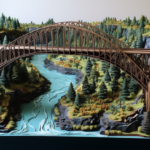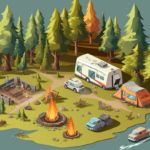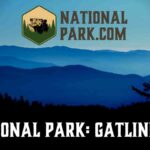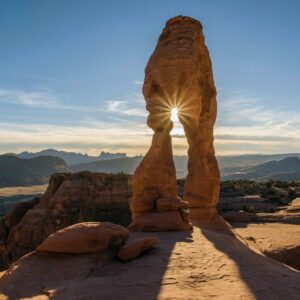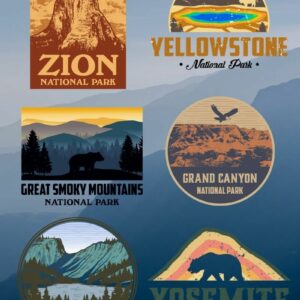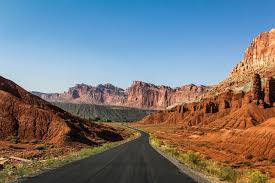Wrangell St. Elias National Park
Wrangell St. Elias National Park is the largest national park in AmericaWrangell-St. Elias National Park, situated in Alaska, is the largest national park in the United States, encompassing over 13 million acres of rugged wilderness. The park features towering mountains, massive glaciers, and diverse ecosystems, providing visitors with a chance to experience the untamed beauty of the Alaskan wilderness. With its vast landscapes and remote location, Wrangell-St. Elias National Park offers a truly unforgettable adventure for those seeking to immerse themselves in the grandeur of nature.
Wrangell St. Elias National Park Geology
Wrangell St. Elias National Park is comprised of 7 exotic terranes
The geology of Wrangell-St. Elias National Park and Preserve in Alaska is a fascinating tale of ice and stone, a testament to the power of natural forces. The park, located in the boreal lowlands of Alaska, is a region known for its permafrost soils and abundant wetlands. The landscape has been shaped over millennia by a variety of geological processes, and the impacts of these processes are still visible today.
One of the most significant geological features in the park is the network of trails created by off-road vehicles (ORVs). These trails, which have been expanding since the 1950s, have caused local resource damage, including denuded vegetation, soil erosion, and permafrost thaw. However, the impacts of these trails extend beyond the local level, affecting stream and watershed processes as well.
A study conducted in 2012 revealed that the ORV trails have led to an increase in trail length and number, as well as an upslope expansion of the trail system around points of stream channel initiation. This has resulted in the premature initiation and headward expansion of channels due to lowered soil resistance and greater runoff accumulation as trails migrate upslope.
Soil monitoring showed earlier and deeper thaw of the active layer in and adjacent to trails compared to reference sites. Several rainfall-runoff events during the summer of 2009 showed increased and sustained flow accumulation below trail crossings and channel shear forces sufficient to cause headward erosion of silt and peat soils.
These observations suggest that ORV trails are altering watershed processes. These changes in watershed processes appear to result in increasing drainage density and may also alter downstream flow regimes, water quality, and aquatic habitat.
Addressing local land-use disturbances in boreal and arctic parklands with permafrost soils, such as Wrangell-St. Elias National Park, where responses to climate change may be causing concurrent shifts in watershed processes, represents an important challenge facing resource managers.
The geology of Wrangell-St. Elias National Park is a complex interplay of natural forces and human activity. The park’s landscape, shaped by ice and stone, continues to evolve, influenced not only by the slow march of geological time but also by the more immediate impacts of human activity. As we continue to explore and enjoy this incredible landscape, it is crucial that we also work to understand and mitigate our impact on its delicate geological balance.

Native American History
Home of the Ahtna peoples
The park is located in a region that has been inhabited by indigenous peoples for thousands of years. The Ahtna and the Upper Tanana are two of the Native Alaskan groups that have traditionally lived in the area.
The Ahtna people have a long history of living in the Copper River Basin, which is located to the west of the park. They traditionally hunted moose, caribou, and Dall sheep in the region, and they also fished for salmon in the Copper River.
The Upper Tanana people traditionally lived to the east of the park, in the Tanana River Valley. They also hunted and fished in the region, and they had trade relationships with other indigenous groups, including the Ahtna.
The indigenous peoples of the Wrangell-St. Elias region had complex social and economic systems, and they were highly adapted to the harsh environment. They had extensive knowledge of the land and its resources, and they developed sophisticated strategies for hunting, fishing, and gathering.
Today, the descendants of these indigenous groups continue to live in the region, and they maintain many of their traditional practices. The National Park Service works with these communities to preserve their cultural heritage and to manage the park’s resources in a way that respects their traditional ways of life.

Wrangell St. Elias National Park History
How Wrangell St. Elias became a National Park
The journey of Wrangell-St. Elias National Park and Preserve to become a national park is a fascinating story of conservation and the recognition of the area’s unique natural and cultural values.
The region that is now Wrangell-St. Elias National Park and Preserve has been home to indigenous peoples for thousands of years. However, it wasn’t until the late 19th and early 20th centuries that the area began to attract significant attention from outsiders, primarily due to the discovery of copper in the region. This led to the establishment of the Kennecott Mines, which operated from 1911 to 1938 and became one of the richest known copper deposits in the world.
Despite the industrial activity, the area’s natural beauty and ecological importance were recognized early on. In the 1960s and 1970s, conservationists began to advocate for the protection of the region. They were particularly concerned about the potential impacts of mining and other industrial activities on the area’s ecosystems and scenic beauty.
Their efforts culminated in the passage of the Alaska National Interest Lands Conservation Act (ANILCA) in 1980. This landmark legislation created 104 million acres of new national parklands in Alaska, more than doubling the size of the national park system. As part of this legislation, Wrangell-St. Elias was designated as a national park and preserve, covering over 13 million acres and making it the largest national park in the United States.
The creation of Wrangell-St. Elias National Park and Preserve was a significant victory for conservation in Alaska. It ensured the protection of the area’s unique ecosystems, which include some of the highest peaks in North America, extensive glaciers, and important habitats for wildlife. It also recognized the cultural importance of the region, which has been home to indigenous peoples for thousands of years and played a significant role in Alaska’s mining history.
Today, Wrangell-St. Elias National Park and Preserve continues to be a place of immense natural beauty and cultural significance. It offers visitors the opportunity to explore vast wilderness areas, learn about the region’s rich history, and experience the awe-inspiring landscapes that make Alaska so unique.

Attractions
The best things to do in Wrangell St. Elias National Park
Wrangell-St. Elias National Park and Preserve, the largest national park in the United States, offers a wealth of attractions for visitors. Here are some of the top attractions in the park:
-
Mount St. Elias: The second highest peak in the United States, Mount St. Elias towers over the park at an elevation of over 18,000 feet. It’s a popular destination for mountaineers, though climbing it is a serious undertaking that should only be attempted by experienced climbers.
-
Kennecott Mines National Historic Landmark: This well-preserved copper mining camp offers a glimpse into the area’s industrial past. Visitors can explore the old mill town, take a guided tour of the 14-story concentration mill, or hike on the Root Glacier trail.
-
Wrangell Mountain Air: Offering flightseeing tours of the park, Wrangell Mountain Air provides an opportunity to see the park’s vast wilderness from above. Highlights include views of towering mountains, expansive glaciers, and the historic Kennecott Mines.
-
McCarthy Road: This 60-mile gravel road takes you through some of the park’s most beautiful landscapes. The road ends at the Kennicott River, just a short walk from the historic town of McCarthy.
-
Nabesna Road: Another scenic drive in the park, the Nabesna Road offers access to hiking, camping, hunting, and wildlife viewing opportunities. It’s less traveled than the McCarthy Road, making it a good choice for those seeking solitude.
-
Hiking and Backpacking: The park offers a variety of hiking and backpacking opportunities, from short day hikes to multi-day backcountry adventures. Popular trails include the Bonanza Mine Trail and the Root Glacier Trail.
-
Wildlife Viewing: The park is home to a variety of wildlife, including grizzly bears, black bears, moose, Dall sheep, and a variety of bird species. Wildlife can often be seen from the park’s roads and trails.
Remember, Wrangell-St. Elias is a remote wilderness area, and many of its attractions are only accessible by foot, boat, or small aircraft. Always be prepared for changing weather conditions and potential wildlife encounters, and consider hiring a guide if you’re planning to venture into the park’s backcountry.

Vegetation
The most common flower in Alaska appears to be the fireweed
In the heart of Alaska, the Wrangell-St. Elias National Park and Preserve (WRST) stretches across a vast and diverse landscape. This park, the largest in the United States, is a wonderland of rugged mountains, glaciers, and high-altitude habitats. But today, we’re going to explore this park from a unique perspective: through the eyes of one of its most iconic inhabitants, the Dall’s sheep.
The Dall’s sheep (Ovis dalli dalli) is a species that has adapted to life in the harsh, high-altitude environments of the Alaskan wilderness. A recent study has shed light on the habitat preferences of these sheep within the park, revealing fascinating insights into the vegetation and terrain of WRST.
The study found that the Dall’s sheep’s habitat selection is heavily influenced by rugged terrain, the normalized difference vegetation index (NDVI), and open landcover types. The NDVI is a measure of vegetation greenness, indicating the presence of lush, nutritious plant life that the sheep depend on for sustenance.
The park’s heavily glaciated landscape, with its rugged terrain and high elevations, provides the perfect habitat for these sheep. The open landcover types preferred by the Dall’s sheep typically include alpine meadows, shrublands, and sparse vegetation, all of which are abundant in WRST.
Interestingly, the study also compared the habitat of the Dall’s sheep with that of their relatives, the Stone’s sheep (Ovis dalli stonei), which live in lower latitude areas. The habitats of the Stone’s sheep are more influenced by fire disturbance and are more forested, showcasing the diversity of environments within the park.
This study provides a glimpse into the rich tapestry of vegetation within the Wrangell-St. Elias National Park, as seen through the eyes of the Dall’s sheep. It’s a reminder of the intricate relationships between the park’s wildlife and their habitats, and how each species has adapted to thrive in their unique environment.
As we continue to explore and understand the complex ecosystems within our national parks, studies like this one offer invaluable insights. They remind us of the importance of preserving these habitats, not just for the wildlife that call them home, but for future generations of humans to appreciate and learn from as well.
For those interested in delving deeper into the study, you can access the full text here. Stay tuned for more fascinating insights into our national parks and the incredible wildlife that inhabit them.
This blog post was inspired by a study titled “Habitat selection by Dall’s sheep in Wrangell-St. Elias National Park and Preserve, Alaska” published in the Journal of Mammalogy.

Animal Life
Alaska has no rabbits?
Wrangell-St. Elias National Park, located in Alaska, is home to a diverse range of fauna, including the Dall’s sheep (Ovis dalli dalli). These sheep are endemic to the alpine areas of sub-Arctic and Arctic northwest America and are of high economic and cultural importance. Their populations have historically experienced large fluctuations in size, with studies linking these declines to decreased productivity as a consequence of late-spring snow cover. However, the impact of the seasonality of snow accumulation and characteristics such as depth and density on Dall’s sheep productivity has been less understood until now.
A recent study examined the relationships between snow and climate conditions and summer lamb production in Wrangell-St Elias National Park over a 37-year period. The researchers used a spatially-explicit snow evolution model, forced with meteorological data from a gridded climate re-analysis from 1980 to 2017, and calibrated with ground-based snow surveys. The model was validated by snow depth data from remote cameras.
The study found that a multiple regression model of fall snow depth and fall air temperature explained 41% of the variance in lamb-to-ewe ratios, with decreased lamb production following deep snow conditions and colder fall temperatures. This suggests that the early establishment and persistence of challenging snow conditions is more important than snow conditions immediately prior to and during lambing. These findings may help wildlife managers to better anticipate Dall’s sheep recruitment dynamics.
The study also highlighted the importance of understanding the impact of climate change on the snow conditions in the park. The terrestrial ecology of the Arctic Boreal region (ABR) is changing rapidly as a result of amplified increases in temperatures. Seasonal snow coverage exists in the ABR for up to 10 months annually and profoundly impacts ecosystem function. Studies point towards continued reduction in the annual duration of snow cover and overall accumulation in the ABR, with region and elevation dependent variations in trend and severity.
The findings of this study underscore the importance of ongoing research into the impacts of climate change on the fauna of Wrangell-St Elias National Park, and the need for adaptive management strategies to ensure the survival of species such as the Dall’s sheep.
You can read the full study here.

Hiking Trails
The best hiking trails in Wrangell St. Elias National Park
Wrangell-St. Elias National Park, the largest national park in the United States, is a hiker’s paradise. It offers a vast wilderness of mountains, glaciers, rivers, and forests, providing countless opportunities for exploration and adventure. However, unlike many other national parks, Wrangell-St. Elias does not have a large network of maintained trails. Instead, it offers a true wilderness experience, where hikers can forge their own paths and explore the park’s diverse landscapes at their own pace.
Here are some of the most popular hiking areas in the park:
-
Nabesna Road: This 42-mile road provides access to a variety of hiking opportunities. Trails along this road include the Caribou Creek Trail, a 3-mile round trip that offers views of the Mentasta Mountains, and the Trail Creek Trail, a more challenging 10-mile round trip that takes hikers through beautiful alpine tundra.
-
McCarthy Road and Kennecott: The 60-mile McCarthy Road leads to the historic town of McCarthy and the old Kennecott copper mines. From here, hikers can explore the Root Glacier Trail, a relatively flat 4-mile round trip that offers stunning views of the Root Glacier and the surrounding mountains.
-
Skookum Volcano Trail: This trail is a moderate 3.5-mile loop that takes hikers up the side of an ancient volcano. The trail offers panoramic views of the Wrangell Mountains and the Copper River Basin.
-
Erie Mine Trail: This trail is a strenuous 8-mile round trip that takes hikers up to the historic Erie Mine. The trail offers stunning views of the Chitina River Valley and the Wrangell Mountains.
-
Backcountry Hiking: For experienced hikers and backpackers, the vast backcountry of Wrangell-St. Elias offers endless opportunities for exploration. Popular areas for backcountry hiking include the Bagley Icefield, the largest non-polar icefield in North America, and the Wrangell Mountains, which include several peaks over 16,000 feet.
Remember, hiking in Wrangell-St. Elias requires careful planning and preparation. The park’s remote location and challenging terrain can pose significant risks, and hikers should be prepared for unpredictable weather, difficult river crossings, and encounters with wildlife. Always check with the park’s visitor centers for the latest information on trail conditions and safety precautions.







